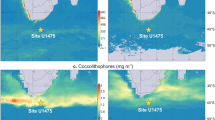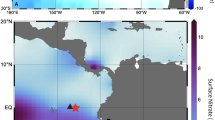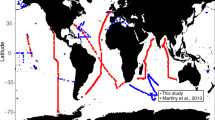Abstract
Glacial to interglacial climate changes have been related to organic carbon cycling in oceanic surface waters1, and this possible link has led to the development of sedimentary tracers of past marine biological production. For example, sediment records of organic carbon2, opal3 and biogenic barium4 have been used to reconstruct past variations in production in different oceanic regimes, but these tracers cannot be used to discriminate between the relative contributions of different phytoplankton groups. Such a discrimination would provide greater insight into the operation of the biological ‘pump’ transporting material down out of surface waters, and into the possible influence of the structure of oceanic food chains on carbon fluxes. Several organic biomarker compounds have now been established for tracing the contribution of different planktonic groups to organic carbon in sediments5,6,7. Here we show that four such biomarkers—dinosterol, alkenones, brassicasterol and chlorins, which represent dinoflagellates, prymnesiophytes, diatoms and chlorophyll-producers, respectively—have concordant concentration maxima that coincide with organic carbon maxima over the past 200,000 years in a sediment core from the northeastern Arabian Sea. Not only do these organic tracers track changes in ocean production in this region, but the similar distributions of dinosterol and brassicasterol indicate that the relative contributions of the dominant members of the phytoplankton community (diatoms and dinoflagellates) to production were roughly uniform on timescales greater than 3,000–4,000 years over the past 200,000 years.
This is a preview of subscription content, access via your institution
Access options
Subscribe to this journal
Receive 51 print issues and online access
$199.00 per year
only $3.90 per issue
Buy this article
- Purchase on Springer Link
- Instant access to full article PDF
Prices may be subject to local taxes which are calculated during checkout



Similar content being viewed by others
References
Sarnthein, M., Winn, K., Duplessy, J. C. & Fontugne, M. R. Global variations and surface ocean productivity in low and mid latitudes: Influence on CO2reservoirs of deep ocean and atmosphere during the last 21,000 years. Paleoceanography 3, 361–399 (1988).
Müller, P. J. & Suess, E. Productivity, sedimentation rate, and sedimentary organic matter in the oceans. Deep-Sea Res. 26, 1347–1362 (1979).
DeMaster, D. J. The supply and accumulation of silica in the marine environment. Geochim. Cosmochim. Acta 45, 1715–1732 (1981).
Dymond, J., Suess, E. & Lyle, M. Barium in deep-sea sediment: A geochemical proxy for paleoproductivity. Paleoceanography 7, 163–181 (1992).
Brassell, S. C. & Eglinton, G. in Molecular Geochemical Indicators in Sediments in Organic Marine Geochemistry (ed. Sohn, M. L.) 10–32 (Am. Chem. Soc., Washington DC, (1986)).
Boon, J. J., Rijpstra, W. I. C., Lange, F. & de Leeuw, J. W. Black Sea sterol—a molecular fossil for dinoflagellate blooms. Nature 277, 125–127 (1979).
Brassell, S. C., Eglington, G., Marlowe, I. T., Pflaumann, U. & Sarnthein, M. Molecular stratigraphy: anew tool for climatic assessment. Nature 320, 129–133 (1986).
Nair, R. R. et al. Increased particle flux to the deep ocean related to monsoons. Nature 338, 749–751 (1989).
Brock, J. C. & McClain, C. R. Interannual variability in phytoplankton blooms observed in the northwestern Arabian Sea during the southwest monsoon. J. Geophys. Res. 97, 733–750 (1992).
Kutzbach, J. E. Monsoon climate of the Early Holocene: climate experiment with the Earth's orbital parameters for 9,000 years ago. Science 214, 59–61 (1981).
Prell, W. L. & Kutzbach, J. E. Sensitivity of the Indian monsoon to forcing parameters and implications for its evolution. Nature 360, 647–651 (1992).
Clemens, S., Prell, W., Murray, D., Shimmield, G. & Weedon, G. Forcing mechanisms of the Indian Ocean monsoon. Nature 353, 720–725 (1991).
Shimmield, G. B. & Mowbray, S. T. The inorganic geochemical record of the northwest Arabian Sea: ahistory of productivity variation over the last 400 k.y. from sites 722 and 724. Proc. ODP Sci. Res. 117, 409–419 (1991).
Rostek, F. et al. in Global Precipitations and Climate Change (eds Desbois, M. & Désalmand, F.) 27–51 (Springer, Berlin, (1994)).
Madhupratap, M. et al. Mechanism of the biological response to winter cooling in the northeastern Arabian Sea. Nature 384, 549–552 (1996).
von Rad, U. et al. Influence of the Oxygen Minimum Zone on the Sedimentation at the Upper Continental Slope off Pakistan, “Pakomin” (Sonne Cruise SO90 Cruise Rep., (1993)).
Wyrtki, K. Oceanographic Atlas of the International Indian Ocean Expedition (NSF, Washington DC, (1971)).
Martinson, D. G. et al. Age dating and the orbital theory of the ice ages: Development of a high-resolution 0 to 300,000 year chronostratigraphy. Quat. Res. 27, 1–29 (1987).
Harris, P. G. et al. Chlorin accumulation rate as a proxy for Quaternary marine primary productivity. Nature 383, 63–65 (1996).
Prahl, F. G., Muehlhausen, L. A. & Lyle, M. An organic geochemical assessment of oceanographic conditions at MANOP site C over the past 26,000 years. Paleoceanography 4, 495–510 (1989).
Volkman, J. K. Areview of sterol markers for marine and terrigenous organic matter. Org. Geochem. 9(2), 83–99 (1986).
Marlowe, I. T. et al. Long chain (n-C37-C39) alkenones in the Prymnesiophyceae. Distribution of alkenones and other lipids and their taxonomic significance. Br. Phycol. 19, 203–216 (1984).
Jenkins, G. M. & Watts, D. G. Spectral Analysis and its Applications (Holden Day, Oakland, (1968)).
Paillard, D. & Labeyrie, L. D. A“user-friendly” Macintosh software for rapid correlations of paleoclimatic signals and treatments(Centre des Faibles Radioactivités PNEDC/INSU, (1993)).
Imbrie, J. et al. in Milankowitch and ClimatePt 1 (ed. Berger, A. L.) 307–330 (1984).
Krey, J. in The Biology of the Indian Ocean (ed. Zeitzschel, B.) 115–126 (Springer, Berlin, (1973)).
Pollehne, F., Klein, B. & Zeitschel, B. Low light adaption and export production in the deep chlorophyll maximum layer in the northern Indian Ocean. Deep-Sea Res. II 40, 737–752 (1993).
Stein, R. in Biochemistry of Black Shales (eds Degens, E. T. et al.) 55–70 (Mitt. Geol. Paläont. Inst., Univ. Hamburg, (1986)).
Wangersky, P. J. The role of particulate matter in the productivity of surface waters. Helgoländer Wiss. Meer. 30, 546–564 (1977).
Hedges, J. E. & Ertel, J. R. Characterization of lignin by gas capillary chromatography of cupric oxide oxidation products. Anal. Chem. 54, 174–178 (1982).
Acknowledgements
We thank P. Parkinson (Civil and Mechanical Engineering, UBC) for providing access to the GC/MS system. C.J.S. was supported by a NATO fellowship provided by the German Academic Exchange Service (DAAD). J.V. was supported by the Spanish Ministry of Education. Laboratory support was provided by NSERC (S.E.C.).
Author information
Authors and Affiliations
Corresponding author
Rights and permissions
About this article
Cite this article
Schubert, C., Villanueva, J., Calvert, S. et al. Stable phytoplankton community structure in the Arabian Sea over the past 200,000 years. Nature 394, 563–566 (1998). https://doi.org/10.1038/29047
Received:
Accepted:
Issue Date:
DOI: https://doi.org/10.1038/29047
This article is cited by
-
Kuroshio Intrusion Combined with Coastal Currents Affects Phytoplankton in the Northern South China Sea Revealed by Lipid Biomarkers
Journal of Ocean University of China (2023)
-
Evidence of bottom-up effects of climate on Japanese anchovy (Engraulis japonicus) in the western North Pacific
Journal of Oceanography (2021)
-
Climate oscillations reflected within the microbiome of Arabian Sea sediments
Scientific Reports (2017)
-
Sediment lipid biomarkers record phytoplankton dynamics of Lake Heihai (Yunnan Province, SW China) driven by climate warming since the 1980s
Environmental Science and Pollution Research (2017)
-
A sediment record of environmental change in and around Lake Lugu, SW China, during the past two centuries
Journal of Paleolimnology (2016)
Comments
By submitting a comment you agree to abide by our Terms and Community Guidelines. If you find something abusive or that does not comply with our terms or guidelines please flag it as inappropriate.



